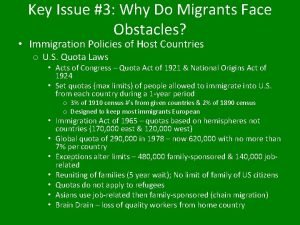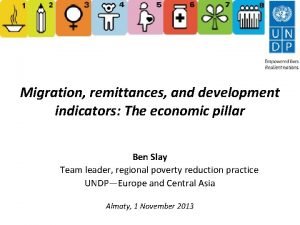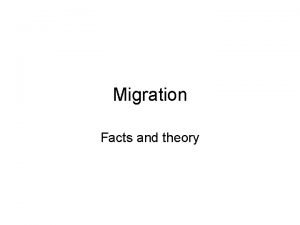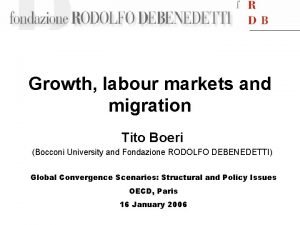International migrants Sociological Analysis International Migrants are ever












- Slides: 12

International migrants Sociological Analysis

International Migrants are ever increasing Numbers are increasing rapidly • • • 1970 82 million 2000 175 million 2005 200 million (counting only those who have lived outside their country for more than one year and including 9. 2 million refugees) This is equivalent to the population of the 5 th largest country Brazil 1 in 35 people is an international migrant; or 3% of the world's population Migrant women • • • Almost half the world's international migrants are women (48. 6%) Some 51 % of migrant women live in the developed world, compared with 49% in the developing world There are more female than male inter national migrants in Latin America and the Caribbean, North America, Oceania, Europe and the former USSR

Geographical Location • 56. 1 million in Europe (including the European part of the former USSR), accounting for 7. 7% of Europe's population • 49. 9 million in Asia, accounting for 1. 4% of Asia's population • 40. 8 million in North America, accounting for 12. 9% of North America's population • 16. 3 million in Africa, accounting for 2% of Africa's population • 5. 9 million in Latin America, accounting for 1. 1 % of Latin America's population • 5. 8 million in Australia, accounting for 18. 7% of Australia's population

Host Countries Year 2000 • USA has some 35 million: 20% of the world's migrants • The Russian Federation has some 13. 3 million: 7. 6% of the world's migrants • Germany has some 7. 3 million: 4. 2% of the world's migrants • Ukraine has some 6. 9 million: 4. 0% of the world's migrants • India has some 6. 3 million: 3. 6% of the world's migrants • Migrants comprise more than 60% of the total population in Andorra, Macao Special Administrative Region of China, Guam, the Holy See, Monaco, Qatar and the United Arab Emirates

Countries of Origin • The Chinese diaspora has an estimated population of 35 million people • The Indian diaspora has an estimated population of 20 million • The Filipino diaspora has an estimated population of 7 million

Changing Pattern • From 1980 to 2000, the number of migrants living in the developed world increased from 48 million to 110 million; compared with an increase from 52 million to 65 million in the developing world • Today, some 60% of the world's migrants live in the developed world • In 1970, migrants comprised 10% of the population in 48 countries; this had increased to 70 countries by 2000 • From 1970 to 2000, the proportion of the world's migrants living in North America rose from 15. 9% to 22. 3%, and in the former USSR from 3. 8% to 16. 8% • From 1970 to 2000, the proportion of the world's migrants living in other parts of the world decreased from: • • • 34. 5% to 25% in Asia 12% to 9% in Africa 7. 1 % to 3. 4% in Latin America and the Caribbean 22. 9% to 18. 7% in Europe 3. 7% to 3. 1 % in Oceania

Causal Factors • Wage disparities: 45. 7 % of people earn less than $1 per day in Sub Saharan Africa; 14. 4% in South Asia, and 10. 4% in Latin America and the Caribbean • Unemployment rates: 12. 2% in the Middle East and North Africa; 10. 9% in Sub Saharan Africa, and 6. 6% in industrialized economies • Differentials in life expectancy: 58 years in low income countries; 78 years in high income countries • Education gaps: 58% women and 68% men literate in low income countries, almost full literacy in high income countries; 76% primary school enrolment in low income countries, almost full enrolment in high income countries • Demographic gradients: on average 5. 4 chil dren born to each woman in Sub Saharan Africa, compared with: 3. 8 in the Arab World; 2. 5 in Latin America and the Carib bean, and 1. 4 in Europe

Economic Contributions • In 2000, some 86 million of the world's migrants were economically active over 50% of all migrants • Foreign workers comprise over 5% of the labour force in 8 European countries • From 1975 to 2001, the number of foreign workers in Japan increased from 750, 000 to 1. 8 million • Skilled immigrants and family members constitute over 50% of migrants entering Australia, Canada and New Zealand

Demographic Impact of Migration • From 1990 to 2000, international migration accounted for 56% of the population growth in the developed world, compared with 3% in the developing world • From 1990 to 2000, immigration accounted for 89% of population growth in Europe • From 1995 to 2000, Europe's population would have declined by 4. 4 million without immigration • From 1995 to 2000 immigration accounted for 75% of population growth in USA

Migrants’ Money Remittance • Formal transfers of remittances were worth about $150 billion in 2004 • Perhaps $300 billion are additionally transferred informally • Formal remittance transfers are almost triple the value of Official Development Assistance • Formal remittance transfers are the second largest source of external funding for Developing Countries after Foreign Direct Investment • The top 3 remittance receiving countries in 2004 were: Mexico ($16 billion per year) India ($9. 9 billion) Philippines ($8. 5 billion) • The top 3 remittance sending countries in 2001 were: USA ($28 billion per year) Saudi Arabia ($15 billion) Belgium, Germany and Switzerland ($8 billion)

Importance of Irregular Migration • An estimated 2. 5 to 4 million migrants cross international borders without authorization each year • At least 5 million of Europe's 56. 1 million migrants in 2000 had irregular status (10%) • Some 500, 000 undocumented migrants are estimated to arrive in Europe each year • An estimated 10 million migrants live in the USA with irregular status • An estimated 50% of the Mexican born population in USA in 2000 had irregular status (4. 8 million) • Some 20 million migrants with irregular status live in India • An estimated 600 -800, 000 people are trafficked each year • Migrant smugglers and human traffickers make an estimated $10 billion profit each year

Refugees and Asylum Seekers • 6. 5 million of the world's 9. 2 million refugees live in developing countries • From 2000 to 2004, the global refugee population decreased by 24% • Refugees represent 23% of international migrants in Asia; 22% in Africa, and 5% in Europe • Pakistan hosts the largest number of refugees; just over 1 million (11 % of the global total) • From 1994 to 2003 some 5 million people applied for asylum in the industrialized countries; refugee or equivalent status was granted to 1. 4 million of them (28%) • In 2004, 676, 000 applications for asylum were submitted in 143 countries; representing a 19% decrease from 830, 300 in 2003 • In 2004, 83, 000 refugees were resettled, mainly in the USA 153, 000), Al. Js/folio (16, 000) and Canada (10, 000)
 Insidan region jh
Insidan region jh Sociological imagination vs sociological perspective
Sociological imagination vs sociological perspective Ever ancient ever new
Ever ancient ever new Ever ancient ever new
Ever ancient ever new Ever ancient ever new
Ever ancient ever new Ever tried ever failed no matter
Ever tried ever failed no matter Protocol against the smuggling of migrants
Protocol against the smuggling of migrants Why do migrants face obstacles
Why do migrants face obstacles Chapter 3 key issue 4
Chapter 3 key issue 4 Key issue 4 why do migrants face obstacles
Key issue 4 why do migrants face obstacles Migrants
Migrants Migrants
Migrants Rapoport
Rapoport























